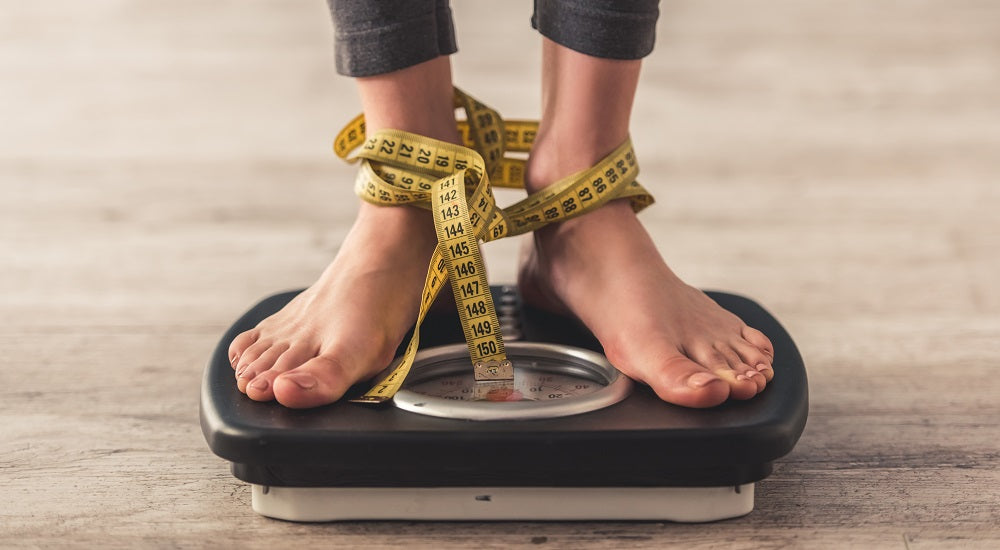Your Cart is Empty
Free shipping on Orders $79+
Free shipping on Orders $79+
Explore

Why BMI Is BS: Healthier Ways to Measure Body Weight and Fat
August 27, 2020 5 min read
We all have our own ways to judge whether or not we need to go on a diet. Some of us may notice that our favorite outfits are getting a little too snug; some might notice some changes in the mirror; others might be happy with their weight.
Yet it's also common to refer to measurements like the body-mass index - commonly known as BMI - to let worry or doubt about our weight creep into our minds. BMI is a very common way for doctors, trainers, and others to measure whether a person is overweight or underweight.
But should we still be using an equation that's almost 200 years old tell us whether or not our weight is healthy? In recent years, experts have discovered just how flawed BMI is when it comes to measuring healthy body weights.
We’re going to show you why BMI is not the be-all and end-all of measuring body weight and fat. Plus, we will show you much healthier ways to keep tabs on your health.
Why BMI Is Flawed
At first, BMI seems pretty straightforward. The equation needed to get your BMI is your weight in pounds multiplied by 703 and then divided by your height in inches squared. For example, if you weigh 198 pounds and your height is 70 inches, your BMI is 28.4.
A BMI of 18.5 and below indicates you are underweight; a BMI between 18.6 and 24.9 indicates a "healthy" weight; a BMI between 25 and 29.9 is overweight; and a BMI higher than 30 is listed as obese.
Many health providers use BMI because it helps them identify potential health issues. Higher BMIs indicate a higher risk for certain diseases, like heart disease and diabetes.
However, one of the major flaws of the BMI is that it doesn't account for sex, age, fat distribution, or bone structure. It solely focuses on weight and height, which can lead to certain people having their body fat being improperly calculated. Additionally, BMI does not account for a difference between fat and muscle, so it's prediction for certain height issues isn't always accurate.
Arecent study estimated that around 74 million people deemed "unhealthy" by the BMI may actually be healthy in the eyes of their doctor.
What's more, Lambert Adolphe Jacques Quetelet created the BMI to measure the degree of obesity of a general population and not for individuals. He was a mathematician and not a physician. Plus, he stated that his index should not be used on an individual level.
This just goes to show why BMI should not be the main indicator of healthiness.
Groups That Don’t Benefit from BMI
Although BMI can be useful for some groups of people, it can be very misleading for others. There are certain demographics of people who should avoid using BMI altogether when it comes to measuring their overall health.
Here are the groups BMI most often gets wrong:
1. Women
A study measuring obesity found that almost half of the women who participated were categorized incorrectly by BMI. When compared to men, women have higher levels of body fat, which can lead to incorrect BMI results.
This is especially true for women who are nursing or pregnant, as they tend to have a higher body fat percentage and weight during this time.
2. Ethnic Groups
The BMI scale is also not a great measurement for certain ethnic groups. Asian people, in particular, may see increased health risks before their BMI classifies them as overweight.
3. Athletes
Anyone who is extremely active will have more muscle and heavier bones that lead to higher weights and higher BMIs. The extra muscle athletes possess is lean mass that increases metabolism and prevents many of the conditions caused by being overweight. So, BMI is obviously not a good way to measure the healthiness of this group of people.
4. Anyone Over Age 65
Traditional BMI groupings do not typically work for those over the age of 65. A BMI of less than 23 for older people comes with a higher health risk, even though it is "healthy" by basic standards. A BMI over 25 is technically "overweight" but those over 65 should shoot for a BMI of 27 to decrease their risk of mortality.
This is because those with a higher BMI often have more muscle, which can reduce fall risk, improve immunity, and be generally beneficial.
BMI Alternatives to Consider
So, now that we have established the many limitations of the body-mass index, what are some better ways to measure your health? Here are our recommendations:
1. Trust How You Feel
BMI is clearly flawed. While it’s smart to trust your health professionals, it’s also important to trust your body and the way you feel. If you feel happy with your current weight, then there’s no need to make any drastic health changes.
If you feel like it’s time to make a change in your health, then begin taking those steps. If you need some support as you get started, you can join ourFacebook group! Our little community is full of juicers trying to make positive health changes, so you can expect support, tips, recipes, and much more.
2. Waist-to-Height Ratio
Waist-to-height ratio is believed to be superior to BMI when it comes to predicting health issues like type 2 diabetes and cardiovascular diseases.
So what is a good waist-to-height ratio? It's recommended that you keep your waist circumference to less than half of your height. A woman who is 5'4", for example, should try to keep her waist to 32 inches or fewer.
3. Waist Circumference
Waist circumference is also a common alternative to BMI. According to the National Heart, Lung, and Blood Institute, men should aim for a waist circumference of fewer than 40 inches and women should stick to 35 inches.
4. Waist-to-Hip Ratio
This measurement is touted by the World Health Organization. You can calculate your waist-to-hip ratio by measuring your hip circumference and dividing it by your waist circumference. A ratio of 0.85 or lower is recommended for women, while a ratio of 0.9 or lower is recommended for men.
Want to Make a Change? Trust Smart Pressed Juice
If you feel like it’s time to make a positive change for your health, Smart Pressed Juice is here to help. One of our top sellers is ourCut Cravings Bundle, which is perfect for keeping your cravings in check and helping you stay on track!
Control your cravings in two simple steps:
Step 1: Cut Your Cravings | 8 AM Vegan Vanilla Proteini
Nourish your body and feel satisfied all day with clean, organic plant-based protein from 10 superfoods like peas, hemp, maca, sacha inchi and sprouts.
Step 2: Undo the Junk | 5 PM Pineapple Chia Cleanse
Feel full and satisfied with activated fiber from sprouts, chia, pineapple enzymes and probiotics. It’s your daily mini-cleanse to ensure you feel light, clean and happy every day. Secret tip: drink this right before that big night out and be amazed at your willpower.
Get yourCut Cravings Bundle today! We promise you’ll love this bundle, as well as our otheraward-winning products!
For more SMART lifestyle tips like this, visitwww.smartpressedjuice.com and follow us onInstagram andTwitter, or like us onFacebook. You can also visit ourAmazon store to stock up on our delicious juices.
Statements made on this website have not been evaluated by the U.S. Food and Drug Administration. Information provided by this website or this company is not a substitute for direct, individual medical treatment or advice. It is the responsibility of you and your healthcare providers to make all decisions regarding your health. We recommend that you consult with your healthcare providers regarding the diagnosis and treatment of any disease or condition. Products sold on this website are not intended to diagnose, treat, cure, or prevent any disease.
{"themeColor":"#574CD5","iconColor":"#574CD5","showLogo":true,"topBottomPosition":10,"rightLeftPosition":10,"iconSize":"small","iconCustomSize":64,"position":"bottom-left"}

